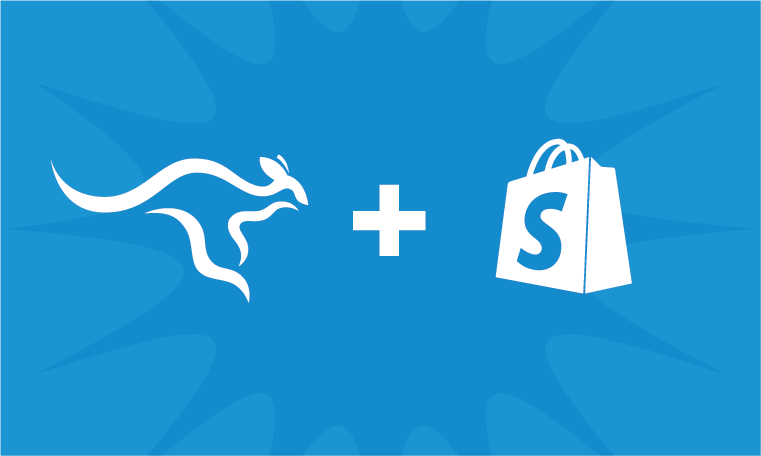
The best way to ensure your survey feedback is legitimate and fits your purpose to the T is to make sure you survey the right candidates.
Businesses often get lost between targeting the right set of participants and surveying all participants to add diversity to the collected data.
Both components are subjectively crucial and depend on the company’s purpose with the collected feedback.
For instance, your brand may want to have more insights into the preferences of a demographic belonging from a particular income bracket, location, relationship status, region, and so on. In which case, diversity is irrelevant in the survey.
While companies can filter out selective feedback from the data silos using AI feedback analytics, it is a waste of resources and respondents’ time since the rest of the data is not useful.
To filter out the demographic, screening questions targeted towards driving relevant responses help. This way, not all users have to take the whole survey, and you won’t end up collecting feedback you don’t want.
That’s where the challenge lies.
What type of questions in a screening questionnaire will filter out the targeted audience?
To answer this, we have curated this guide to help you identify the types of screener questions you can use and how to use them in the best way.
Let’s begin by understanding what they are.
What Are Screening Questions?
Screening questions, popularly known as Screeners, are the questions you ask in a survey with the definite purpose of filtering out the specific type of respondents from the whole.
Screeners are used to prequalifying the respondents from a large pool of users and collect only their feedback for more concise and accurate results.
Naturally, these questions are asked initially and can be presented at the time of general demographic screening.
There are four types of screener user research survey questions, which we will discuss shortly after we go through the benefits of conducting a screener survey.
Benefits of Using Screening Questions for Surveys
So far, we established the relevancy and the pivotal role screeners play in conducting a targeted survey successfully. It is now time to look at the advantages companies reap from screening questions in surveys.
Target relevant respondents
Apart from all the ancillary reasons, filtering out the relevant from irrelevant respondents for a specific survey is a significant benefit of using screening questions. It ensures the audience fits into the criteria for the survey.
For example, let’s say you want to find out how many parents prefer to buy toys or study material online and have bought either of them in the past 12 months. You will need to ask the two essential screening questions:
- Do they have kids?
- When was the last time they bought either of the items?
Increase efficiency
Taking forward what we discussed in the beginning, other alternatives to filter out respondents is by creating surveys, paying for ads for a survey, buying or creating email lists to send them around, etc., which are inefficient on both time and cost fronts.
You would end up collecting more feedback than needed, with lesser results than required and a lot of irrelevant information.
Qualifying screening questions in a survey are a much efficient way to survey less and gather more relevant information with less effort, money, and time.
Keep feedback relevant and unbiased
More often than not, surveying users randomly invites biased and meaningless feedback.
The unqualified respondents may lack knowledge in that area or might have biases from previous experiences, affecting their feedback. The data procured from the random surveys will be not only meaningless to the company but also misleading if pursued.
Save user experience from going down the drain
Imagine this as a user – You go onto a website, get invited to take a survey you didn’t want to in the first place, take the survey, and half-way through, you realize it’s irrelevant to you.

Such a situation will increase the survey abandonment rate and put a damper on user experience. A screener ensures that users do not waste their time on surveys not suitable for them.
Efficient data analysis
Screening questions segregate the required responses from the meaningless ones, saving many resources that would go waste otherwise by identifying one from the other manually.
Now that you know why using such questions matters, it’s time to discover which types would be suitable for your purpose.
Types of Screening Questions
While some may consider only two, there are four types of questions you can ask in your screening survey. Each type caters to different purposes and procures different results. Let’s get right into them:
Demographics

It is the most basic and commonly used screener. There are many types of questions you can ask in this category. For example, you can gather data on their gender, age, ethnicity or race, marital status, sexual orientation, do they have children or not, and other things.
Here are some survey example questions –
Qualification: “Please mention your highest qualification.”
Income level: “What is your net household income?”
Marital status: “How would you explain your marital status?”
*Note: Always mention the “Prefer not to say” option for personal and sensitive questions.
Employment type: “What is your employment status as of now?”
Behavioral
Apparent from the name itself, Behavioral questions focus on gauging how respondents behave regarding certain things, their tendencies, and how they make decisions.
For instance, if you want to survey how many people shop for clothes online, the first question that will help understand their behavior is:

If the response is suitable to what you are looking for, you can follow up with another question like:
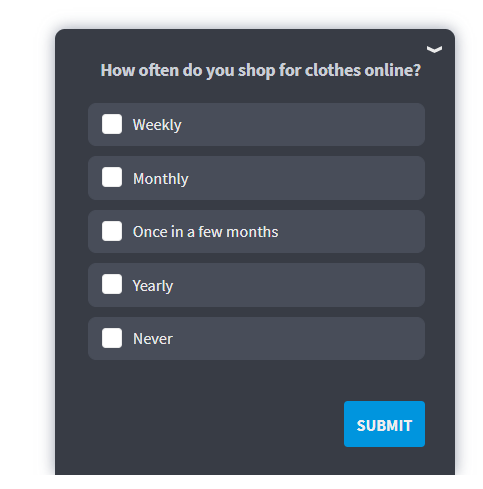
With this question, if you want to target only customers who shop frequently, you will quickly rule out those respondents who shop yearly or never shop online for clothes. Other examples are:
- You want to launch a music streaming service like Spotify – “How much time do you spend listening to music on apps?”
- You want to create an app like Calm – “Do you listen to slow songs and nature audios to help you sleep better when you can’t?”
- Develop an app like Flo, which tracks and predicts the menstrual cycle – “How often do you forget to track your period date and cycle?”
Industry-Specific
Industry-specific questions are great for eliminating biased participants or filtering out those who aren’t related to the specific industry.
To help you understand better, say you deal in digital solutions and products, and you want to gather feedback on marketing-specific solutions.
To eliminate any competitors from responding and get unbiased feedback or only target participants with a marketing background, you can ask-
“Which industry are you working in currently?” or something like this:
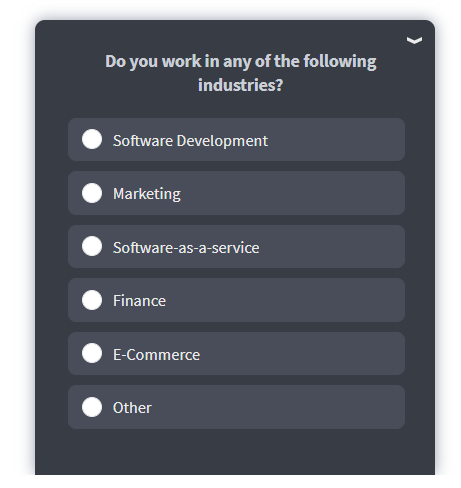
Product or Service-Specific
As evident from the name, this is the type to use if you want to target the audience for whom the product or service is intended.
For example, say you run a hotel chain and are starting a grooming service that’s meant for certain pets of a specific size. You can conduct a survey where the participants can choose options, and anyone not fitting into your requirement will not qualify for the service.
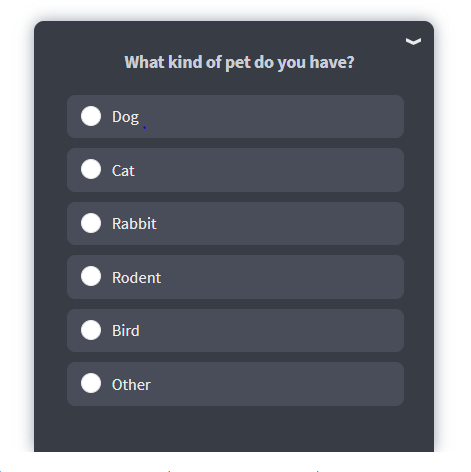
Tips on how to use screeners effectively
Merely stating the types of screening questions will not help you on the practical side of things. So, we will now discuss the most optimized ways to put these screener question types to use.
Do’s of a screening questionnaire
Place screening questions before the actual survey
The whole point of screeners is to eliminate unsuitable candidates in the very beginning. You need to ask your screening questions at the beginning of the actual survey to avoid inconvenience to the respondents and your company.
Make sure to include enough screening questions
Do not hold back too much in asking the crucial questions. It’s okay to ask more than one question at this stage if it helps you get closer to your targeted demographic and improve your response quality. However, you do not want to get overboard. Just stay concise and relevant.
Google suggests a maximum of four screeners and that too when absolutely necessary. That leaves you with two-three questions per screener ideally.
Ask questions for all target demographic criteria
It is crucial to ask the right questions to get the best results. And what are the right questions?
In this case, questions relevant to your selection criteria will pass the “right question” milestone. Let’s understand this better with an example.
Let’s say you own a dating app and the majority of your user base belongs to the 18-35 age bracket. You want to expand your user base and break into the older age bracket of 35-45 by redirecting your marketing efforts in this direction.
You would want respondents belonging to this targeted age group, so the question you should ask should be –
“Which age group do you belong to currently?”
You can add ethnicity, race, gender to the survey if you want such information.
*Note: When forming demographic questions about ethnicity or race, try to add options in groups. Always add options like “Prefer not to say” and “Other” since it is a sensitive demographic.
The questions would look like this –

Here is another elaborate example to further help our cause.
Suppose you are creating a pet supplies on-demand delivery app. If you want to gauge how and for whom your targeted customers order pet food, you need to target an audience who uses apps to order supplies or atleast have a pet for which you provide products.
To ask the right questions for each targeted demographic, you need the ‘right’ criteria.
In this case, it will only include people who shop for supplies at least once a month.
You may not need to ask people who regularly order supplies online via apps.
Now, coming to the part about asking the ‘right’ questions for these criteria:
Right question:
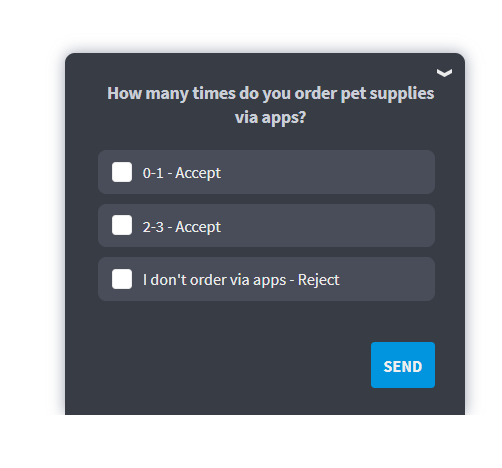
Wrong question:

Choose the right order for your questions
To zero in on your most relevant audience since the beginning, you need to drive in a dynamic demographic. Taking the on-demand pet supplies app example forward, to reach the audience you want to survey, start with a demographic survey to bring a diversity of locality, animal type, etc.
Here again, we have explained the “right” and the “wrong” criteria to consider as responses.
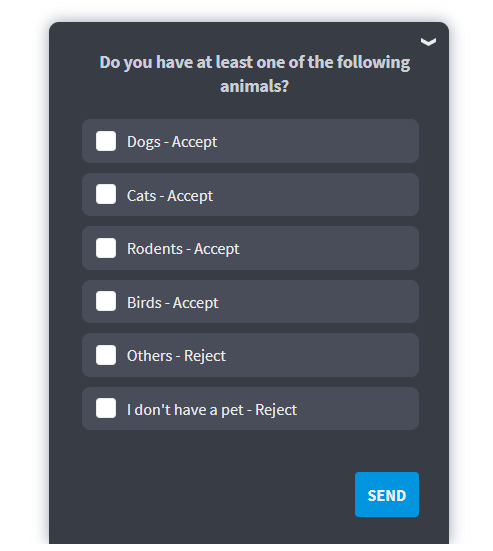
Doing this will filter out the people who do not have a pet and are not your targeted customers.
Then, before you ask how users use the pet supplies app on their devices, you need to ask whether they even use smartphones or which platforms, to be precise.
For example:
Ask this survey example question first –
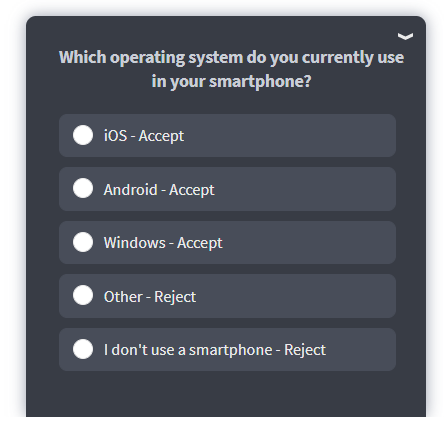
And then add secondary criteria to zero in on your relevant audience –

Offer a catchall answer option
No matter how relevant the answer choices you provide are, sometimes you can’t always assume what users may want to answer. That’s why a catchall answer option such as “None of the above,” “I don’t know,” or “Other” is an excellent idea to practice.
If not, some respondents who shouldn’t be taking your survey might end in your feedback, which can be misleading for your company and defeat your survey’s whole purpose.
Prioritize psychographics and behavior screening
Here is a little something to explain what it is –
Psychographics is a study to analyze consumers’ behavior based on AIOs (Activities, Interests, and Opinions). It helps organizations understand their customers and then strategize marketing and product features.
Psychographics and behavior screening allow grouping people on a specific basis for more effortless and optimized analysis. For instance, how people live, how they are related to your product, what matters to them, etc.
You should only add geographics to your screening question when vital to your research, so you don’t end up wasting your questions. For example, for your pet products app, you must know users’ location to decide which areas are beneficial to target.
Nevertheless, demographics coupled with behaviors and psychographic survey questions might not help eliminate irrelevant respondents, but they do work as a filter to add variety to your survey respondents.
The insights you get from such psychographic survey questions are great for devising marketing strategies for your product.
A page break is a must after the last screener
Do not forget to add a page break after you are done with your last screener. If you don’t, the logic you used in the survey will not apply otherwise.
- Use open-ended questions to eliminate low-quality participants
Think of this as the last stage in your screener survey to land you the exact user persona you want to target. After all, you are conducting a specific survey to get accurate and valuable insights.
Any unuseful or irrelevant feedback will only render your whole survey ineffective. Using an open-ended question, in the end, will let you know more deeply about the participant and help decide whether they are suitable for the survey or not.
For example – You own an online clothing store and want to expand to the beauty industry.
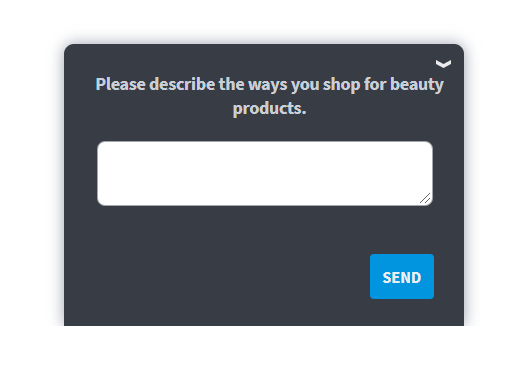
An open-ended question like this in your screener will help you understand how your targeted audience shops for beauty products. This will allow you to make your decisions on users’ shopping behavior and pattern.
Any responses with one-worded, cagey, and incomprehensible answers will indicate low-quality feedback from the respondent. Such respondents will be filtered in the screener.
Don’ts of a screening questionnaire
Don’t use dichotomous answer options.
If you use “Yes” or “No” answer types in your survey, the participants become prone to acquiescence bias, where they would choose the favorable option to seem more agreeable.
Avoid using industry jargon
For your survey to be effective and appropriate for users to take, you should avoid using industry jargon and terminologies. In case you can’t help it, make sure you define it in the survey.
Example: Assume you own an app development company and want to expand to a platform where people can create their apps from scratch in a couple of hours.
This concept comes under Rapid app development, where apps are created in hours and not months with almost no investment. Now, people who are new to app development might not know what this means.
Wrong question: “Would you be interested in a Rapid app development platform?”
Right question: “Would you be interested in a platform where you can create an app yourself without coding in a couple of hours?”
See how simplified and easy to understand the last option is?
This way, even people who might not be familiar with the app development word will be able to answer properly.
Avoid asking leading questions
Do not lead your participants to answer a certain way with your questions. For instance, adding the “right?” term in your questions is a form of validation of what you are asking. And users may choose “Yes” as a favorable answer. But it’s not the only way.
Example:
Wrong Question: On a scale of 1-10, how much will you rate your love for pizza?
Or
On a scale of 1-10, how much do you hate pineapple pizza?
The words “love” and “hate” instantly give a clue to the respondents about your bias in the question, i.e., you may favor responses who rate highest for “hate pineapple pizza.”
If you frame your screening questions in such a way, you may end up with wrong respondents or, worst, inaccurate results.
A non-leading screening questions example is:
Right Question: On a scale of 1-10 (1 being terrible and 10 being incredibly delicious), how will you regard pineapple pizza?
Don’t give away the topic of your survey
You need to cleverly frame and order your questions not to allow respondents to guess what kind of answers would qualify them to move to the next question.
When to use Screening Questions: Use Cases
Other than filtering out the targeted survey respondents, screening questions have much more to offer as business benefits. Here are some use cases where you can get excellent results if you play your cards right with the screeners.
Conversion rate optimization
With screeners, you will be able to eliminate unsuitable candidates for your survey, but it doesn’t mean those candidates cannot provide you anything. Once they have reached your screener, it is best to increase their user experience by guiding them towards something valuable or gather feedback different from your survey.
With the help of branching logic, you can redirect your visitors to your website’s engaging and relevant sections to help them with whatever they need help with.
Check out this video on how the branching logic works and how you can utilize it to increase your conversion rate.
Design feedback
Sometimes, you may design your website or app user interface to the best of your capability, but it is always beneficial to ask for feedback from the people who use it regularly.
You can employ branching logic to connect your screener survey with the one that will collect visitors’ feedback on how easy it is to navigate your website or app or how you can improve your product’s design.
Product feedback
You can gather valuable insights from the rejected respondents about your services or products. Find out how they feel about your organization, what features they would like to be added, and how you can make the whole experience better for them.
If you are a software product or service provider, you can redirect the respondents to the System Usability Scale or SUS survey to gauge how easy-to-use are your services and products.
App feedback
Hypothetically, if you’re conducting your screener survey in your mobile app, then you can utilize the feedback of eliminated respondents about your app and its features.
Related Read - How to Collect and Benefit From In-App Feedback
How to measure incidence rate?
Once you are done creating the screener survey, there is one more crucial step to consider – How many responses do you need to validate your survey efforts?
The practice of calculating the number of respondents who qualify to take your survey is known as “incidence rate.”
It helps decide the minimum number of responses you need from non-screeners to get valuable feedback from the screeners.
Here is how you calculate it:
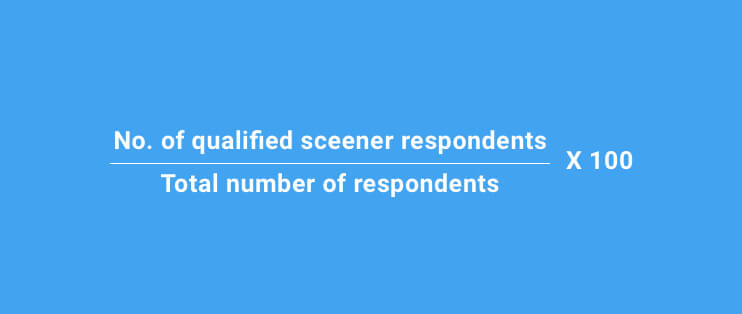
To put it into context, say you got 1000 responses from participants. Out of which 700 pass your screeners, and 300 do not. Then, it leaves you with the incidence rate of:
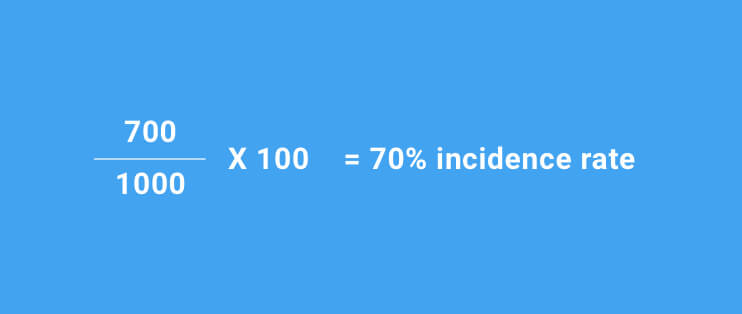
The question now is, why do you need it?
It helps identify the total number of respondents you need to get the minimum required qualified participants.
So, if you guess too high, you are likely to survey fewer people hoping they will be sufficient, only to find out the estimate was incorrect. In this case, you will have fewer than the required qualified respondents and vice versa.
Let us explain this within context. Suppose you guesstimated the incidence rate at 50%, but it turned out to be only 25%. Your actual requirement for qualified respondents is 500.
It means that out of 1000 respondents, only 250 were qualified to take the survey, and because you estimated a higher incidence rate, you are falling short of 250 more qualified candidates.
That’s why you need an accurate incidence rate so that you don’t end up with a surplus or deficit of required qualified participants.
Analysis
Everything that you have done so far leads to this.
It is finally time to understand the feedback data inside out and procure every ounce of useful information by reading between the lines.
While analyzing, you should not confuse total responses for complete responses and vice versa.
While total responses include everyone who took the survey, even the non-screeners, complete responses only include the number of respondents who completed the survey to the end.
When sharing the sample size of the survey questions’ responses, you should use the complete responses figure since total responses will include the non-screeners and would misinterpret your survey results.
It is easy to get confused while identifying which data figures to choose for correct results. For this, you can try tools like Qualaroo featuring a strategized and clean dashboard to avoid confusion and assist you in analyzing survey feedback data efficiently.
Example:

Now that you have landed the right audience, you can start with your actual survey. Here is a video to help you get started and uncover the questions you can ask your chosen respondents.
Get ready to use screeners the right way
Absorbing and implementing everything about how, when, where, and with whom to conduct a screeners survey will offer you the desired results.
Weeding out unsuitable candidates before starting your survey will help you get niche feedback and narrow down the chances of irrelevant responses.
But for your screening endeavors to be fruitful, you need to keep all the pointers discussed in mind and use a tool that allows you advanced filtering options.
FREE. All Features. FOREVER!
Try our Forever FREE account with all premium features!






